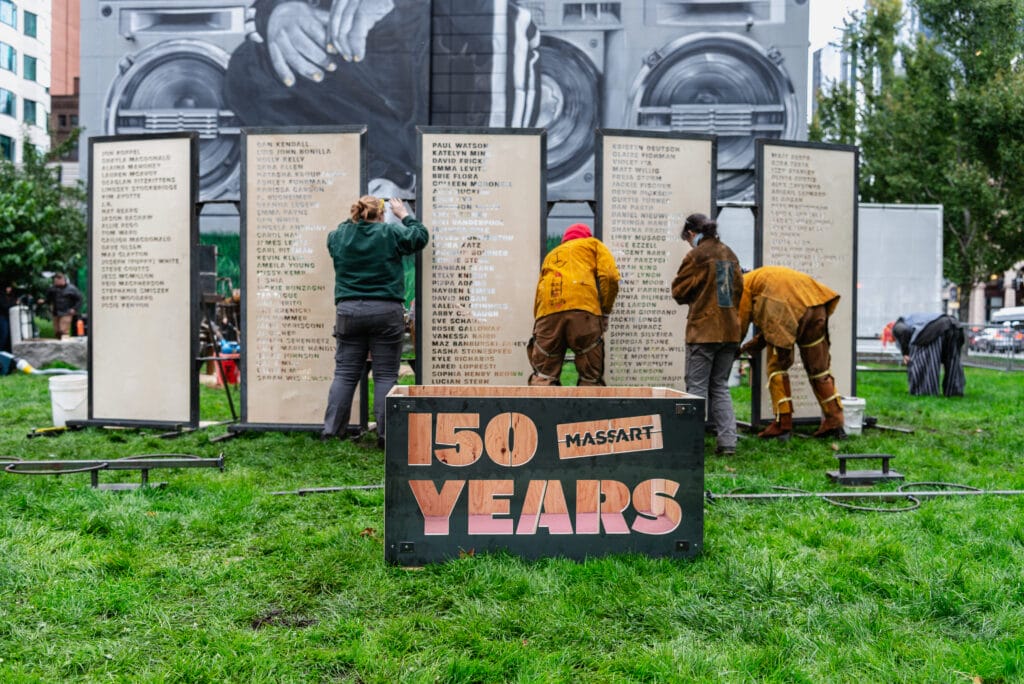MassArt offers two NAAB-accredited programs, the M.Arch Track I (102 credits) and M.Arch Track II (60 credits).
Accreditation
In the United States, most registration boards require a degree from an accredited professional degree program as a prerequisite for licensure.
The National Architectural Accrediting Board (NAAB), which is the sole agency authorized to accredit professional degree programs in architecture offered by institutions with U.S. regional accreditation, recognizes three types of degrees: the Bachelor of Architecture, the Master of Architecture, and the Doctor of Architecture.
A program may be granted an eight-year, three-year, or two-year term of accreditation, depending on the extent of its conformance with established educational standards.
Doctor of Architecture and Master of Architecture degree programs may require a pre-professional undergraduate degree in architecture for admission. However, the pre-professional degree is not, by itself, recognized as an accredited degree.
MassArt offers the following NAAB-accredited degree programs:
M. Arch. Track I – 102 Credits (non-pre-professional degree + 42 pre-professional credits + 60 graduate credits)
M. Arch. Track II – 60 credits (pre-professional degree + 60 credits).
This program leads to the following professional licenses: ARE through NCARB. Please look up your state’s professional licensure agency contact information to determine whether MassArt’s program meets your state’s requirements for licensure.
The National Architecture Accrediting Board (NAAB) granted the MassArt Master of Architecture degree program an eight-year term of accreditation effective January 1, 2024.
The next accreditation visit for the M.Arch program is 2032.
The Architecture Program Report (APR) is a narrative document and an instrument of the accreditation process. It is comprehensive and self-analytical study and outlines how the program meets each of the conditions for accreditation. This process is outlined in detail in the NAAB Conditions and Procedures for Accreditation.
2023 Architecture Program Report (APR)
The Visiting Team Report (VTR) is the team response to the visit and team assessment of evidence provided in the APR and Team Room (digital and/or physical).
2024 Visiting Team Report (VTR)
The Plan to Correct addresses any conditions “not met” indicated in the NAAB accreditation decision letter. MassArt’s Plan to Correct addresses 2 conditions. NAAB voted to accept our Plan to Correct and approve the program for the remainder of the term of accreditation at their October 2025 meeting.
The purpose of the Annual Report is to update program records and provide information about each program’s continuing compliance with the Conditions for Accreditation during the program’s accreditation cycle.
2012 Annual Report Narrative
2011 Annual Report Narrative
2010 Annual Report Narrative
Additional Reports
To understand the context for reviews – see the following documents published by NAAB:
The following documents link to NAAB.org.
Current conditions and procedures,
DOCUMENTS IN EFFECT DURING THE LAST ACCREDITATION VISIT:
2020 NAAB Conditions for Accreditation
2020 NAAB Procedures for Accreditation
The year 2014 is the first year for which MassArt has ARE Pass Rates to report. In 2016, the first MassArt M.Arch graduates received their architecture licenses in Massachusetts.
To better understand the interrelationship between the student, educational and professional organizations refer to the following resources:
PROFESSIONAL AND STUDENT ORGANIZATIONS
American Institute of Architects (AIA)
American Institute of Architecture Students (AIAS)
Boston Society of Architects (BSA)
Association of Collegiate Schools of Architecture (ACSA)
National Council of Architectural Registration Boards (NCARB)
National Architectural Accrediting Board (NAAB)
National Association of Minority Architects (NOMA)
https://www.bosnoma.org/ (BOSNOMA)
Society of American Registered Architects (SARA)
LICENSURE
NCARB is the primary site for Licensure.
From there you can understand how to start an NCARB Record.
NCARB’s Architectural Experience Program (AXP) provides resources for internship reporting, and an app to use in reporting and professional experience hours with supervising professionals. On NCARB’s site, Gain AXP Experience, find information on AXP and download the AXP App.
The following brochures are also available at ncarb.org:
- Architect Registration Examination Guidelines (ARE)
- Architectural Experience Guidelines (AXP)
- Certification Guidelines (registration in multiple states)
- Gain International Reciprocity
Look up your state’s professional licensure agency contact information to determine specific requirements for licensure as states vary.
LICENSING ADVISOR
M.Arch Program Director Paul Hajian MassArt’s AXP/Licensing Advisor. Paul works closely with students and MassArt’s Career resources office to identify job opportunities for students and recent graduates, and guides students through the internship and licensing exam registration. Paul may be reached at phajian@massart.edu.
HANDBOOKS AND ARTICLES
- Your Guide to a Career in Architecture
- NAAB School Search
- StudyArchitecture.com
- NCARB Becoming an Architect
- American Institute of Architecture Students
BOOKS
- Cuff, D. (1992). Architecture: The Story of Practice. MIT Press.
- Blau, J. R. (1987). Architects and firms: A Sociological Perspective on Architectural Practice. MIT Press.
- Herrmann, R. F., & Llp, M. &. H. (2012). Law for Architects: What You Need to Know. W. W. Norton & Company.
- Klein et al. (2013). The Architect’s Handbook of Professional Practice. John Wiley & Sons.
- Klein, R. M. (2010). The Architect’s Guide to Small Firm Management: Making Chaos Work for Your Small Firm. John Wiley & Sons.
- Fisher, T. (2000). In the Scheme of Things: Alternative Thinking on the Practice of Architecture. University of Minnesota Press.
CAREER DEVELOPMENT RESOURCES
MassArt has a robust career development office that provides services for resumes, cover letters, job internships, and building portfolios.









